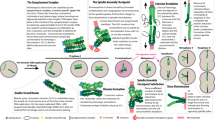Summary
The cytological behavior of the spindle apparatus was studied in cells prone to nondisjunction (ND), i.e., PHA-stimulated lymphocytes derived from children suffering from different types of neoplasia. These cells, which exhibited a high frequency of nonspecific aneuploidy, revealed an increased resistance of the spindle fibers to colchicine, podophyllotoxin, and cold, wich was several times that of lymphocytes derived from healthy children. The results are in accord with previous findings showing a high resistance of spindle microtubules to the antimicrotubular agents colchicine, podopyllotoxin, vinblastine, and cold in PHA-stimulated lymphocytes derived from individuals prone to meiotic ND. It is therefore assumed that high resistance of the spindle apparatus to antimicrotubule agents characterizes cells at high risk for aneuploidy, and possibly, the overstabilized spindle fibers are responsible for failure of chromosomal disjunction.
Similar content being viewed by others
References
Andersen O, Ronne M, Nordberg GF (1983) Effects of inorganic metal salts on chromosome length in human lymphocytes. Hereditas 98: 65–70
Avivi L, Feldman M (1973) The mechanism of somatic association in common wheat, Triticum aestivum L. IV. Further evidence for modifications of spindle tubulin through the somatic-association genes as measured by vinblastine binding. Genetics 73: 379–385
Avivi L, Feldman M, Bushuk W (1970a) The mechanism of somatic association in common wheat, Triticum aestivum L. II. Differential affinity for colchicine of spindle microtubules of plants having different doses of the somatic-association suppressor. Genetics 65: 585–592
Avivi L, Feldman M, Bushuk W (1970b) The mechanism of somatic association in common wheat, Triticum aestivum L. III. Differential affinity for nucleotides of spindle microtubules of plants having different doses of the somatic-association suppressor. Genetics 66: 449–461
Azzarone B, Pedulla D, Romanzi CA (1976) Spontaneous transformation of human skin fibroblasts derived from neoplastic patients. Nature 262: 74–75
Bernhardt R, Matus A (1984) Light and electron microscope studies of the distribution of microtubule-associated protein 2 in rat brain: a difference between dendritic and axonal cytoskeletons. J Comp Neurol 226: 203–219
Bond DJ, Chandley AC (1983) Aneuploidy. (Oxford monographs in medical genetics, no 11) Oxford University Press, Oxford
Cambray-Deakin MA, Burgoyne RD (1987) Posttranslational modifications of α-tubulin: acetylated and detyrosinated forms in axons of rat cerebellum. J Cell Biol 104: 1569–1574
Cleveland DW, Sullivan KF (1985) Molecular biology and genetics of tubulin. Annu Rev Biochem 54: 331–365
Danes BS (1981) Occurrence of in vitro tetraploidy in the heritable colon cancer syndromes. Cancer 48: 1596–1601
Danes BS, Lynch HT (1983) Increased in vitro tetraploidy in dermal monolayer cultures derived from normals. Cancer Genet Cytogenet 8: 81–87
Dotan A, Avivi L (1986) Increased spindle resistance to antimicrotubule agents in women of high risk for meiotic nondisjunction. Hum Genet 73: 199–204
Dustin P (1984) Microtubules, 2nd edn. Springer, Berlin Heidelberg New York
Evans HJ (1985) Neoplasia and cytogenetic abnormalities. In: Dellarco VL, Voytek EP, Holaender A (eds) Aneuploidy, etiology and mechanisms. Plenum Press, New York, pp 165–177
Ford JH (1984) Spindle microtubular dysfunction in mothers of Down syndrome children. Hum Genet 68: 295–298
Ford JH, Russell JA (1985) Differences in the error mechanisms affecting sex and autosomal chromosomes in women of different ages within the reproductive age group. Am J Hum Genet 37: 973–983
Hassold TJ, Jacobs PA (1984) Trisomy in man. Annu Rev Genet 18: 69–97
Kopelovitch K, Bias NE, Nelson L (1979) Tumour promoter alone induces neoplastic transformation of fibroblasts from humans genetically predisposed to cancer. Nature 282: 619–620
LeDizet M, Piperno G (1986) Cytoplasmic microtubules containing acetylated α-tubulin in Chlamydomonas reinhardtii: spatial arrangement and properties. J Cell Biol 103: 13–22
Miller RW, Todaro GJ (1969) Viral transformation of cells from persons at high risk of cancer. Lancet I: 81–82
Mittelman F (1985) Catalog of chromosome aberrations in cancer. Liss, New York
Ohno S (1974) Aneuploidy as a possible means employed by malignant cells to express recessive phenotypes. In: German J (ed) Chromosomes and cancer. Wiley, New York, pp 77–94
Rhim JS, Huebner RJ, Arnstein P, Kopelovitch L (1980) Chemical transformation of cultured human skin fibroblasts derived from individuals with hereditary adenomatosis of the colon and rectum. Int J Cancer 26: 565–569
Sandberg AA (1980) The chromosomes in human cancer and leukemia. Elsevier/North-Holland, New York
Staessen C, Maes AM, Kirsch-Volders M, Susanne C (1983) Is there a predisposition for meiotic nondisjunction that may be detected by mitotic hyperploidy? Clin Genet 24: 184–190
Stallard R, Haney NR, Frank PA, Styron P, Juberg RC (1981) Leukocyte chromosomes from parents of cytogenetically abnormal offspring: preliminary observations. Cytogenet Cell Genet 30: 50–53
Author information
Authors and Affiliations
Rights and permissions
About this article
Cite this article
Avivi, L., Dotan, A., Ravia, Y. et al. Increased spindle resistance to antimicrotubule agents in cells prone to chromosomal nondisjunction. Hum Genet 83, 165–170 (1989). https://doi.org/10.1007/BF00286711
Received:
Issue Date:
DOI: https://doi.org/10.1007/BF00286711




